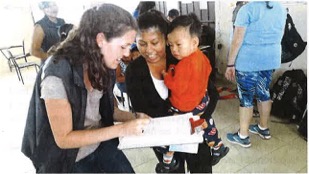Summer Archives
Catie O'ReillyAnconcito, Ecuador - The Foundation/or International Medical Relief of Children |
 To begin, how did I, a mere Vanderbilt University rising junior with no children, find myself mock breastfeeding a plastic doll for a handful
To begin, how did I, a mere Vanderbilt University rising junior with no children, find myself mock breastfeeding a plastic doll for a handful
of experienced mothers? My expectations for developing curriculum for reproductive health of women and adolescents in Anconcito, Ecuador somehow did not include this particular scenario. They tell us every year throughout our Ingram experience that our summer
project will not be what we expected, and no matter how much planning we put in, some things will change. We nod and agree, but do not necessarily expect to be sitting at a plastic table in a nutrition class in rural Ecuador with a babydoll cleverly named 'Concepcion,' teaching the proper positions for breastfeeding a newborn. This was through my opportunity to work with The Foundation for International Medical Relief of Children's new site in the tiny fishing town of Anconcito for my Ingram Summer Project, where I spent two months developing reproductive health curriculum for the organization and revitalizing their nutrition program.
My project was two-fold in this sense, and initially I did not expect to be working on anything regarding nutrition. My proposal was solely for developing materials for reproductive health needs, because in my past Skype calls with my boss Natalie, she explained how FIMRC's site research in Ecuador found drug abuse, malnutrition, and teenage pregnancy to be the biggest hurdles in this community's health system. I felt I was most educated in the realm of teenage pregnancy in developing countries, so focused my research here. However, after my first two weeks with FIMRC I found that they were too short-staffed during the normal work year to be able to introduce any new programs that would actually be sustainable. My task shifted to being able to develop resources for their database regarding the costs of pregnancy versus available jobs in the community, presentations on the specific pregnancy statistics in Anconcito, and many other resources that can be easily used in a variety of their programs. We rolled out as many of them as we could to evaluate their effectiveness, using FIMRC's Health Promotores program of teenagers since we were developing the curriculum for that program as we went. I implemented a well-tested HIV/AIDS teaching form called 'Grassroots Soccer' for a Health Promotores class, in which students learned useful information about the diseases through soccer drills to keep them interested.
To address the mock breastfeeding, I found that my passions aligned with where FIMRC needed me more this summer, which was the realm of nutrition. I was nervous to really dive into their strong nutrition program, because it seemed fully developed and I did not know much about nutrition education. However, they needed fresh eyes and technological development. I developed a follow-up program for the kids that had graduated from the nutrition classes, led classes on breastfeeding, exercise, and many many many classes on MyPlate, and helped to expand the program to five local preschools. Nutrition brought me closer to our nutritionist Estefania, who taught me more about the country's culture than anybody else, and the nutrition expansion showed me just how bureaucratic Ecuador's public health system is. It was a difficult project, but I have hope that I did everything in my power, including fake breastfeeding, to make my program enhancements sustainable and strong.
